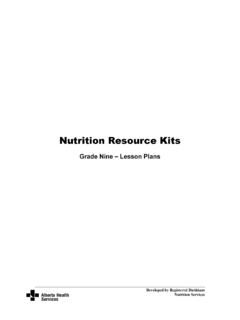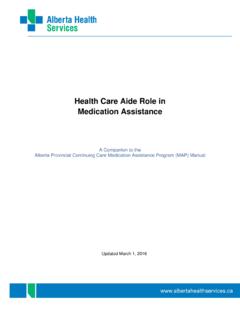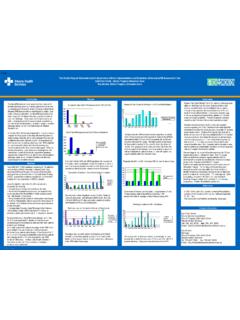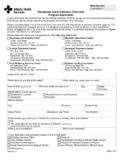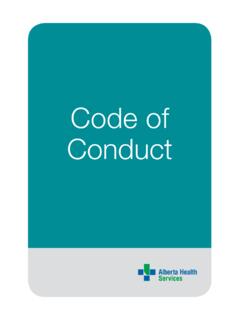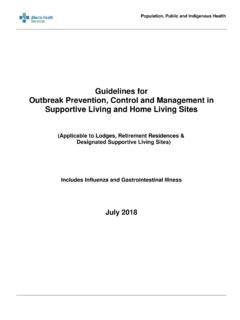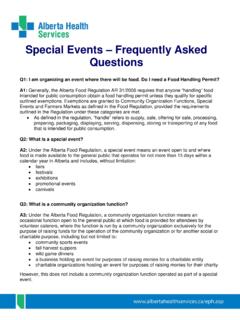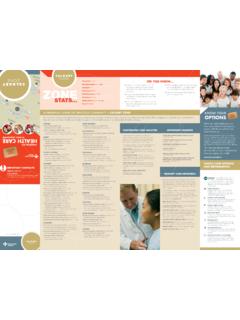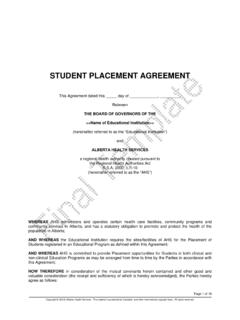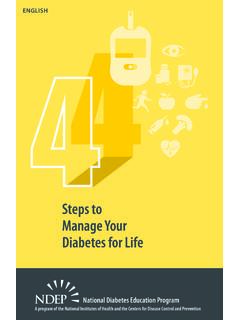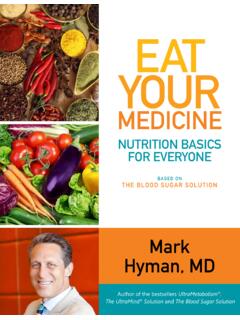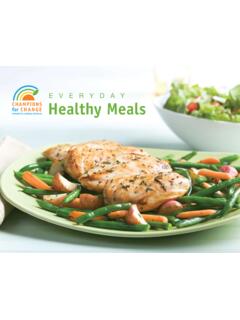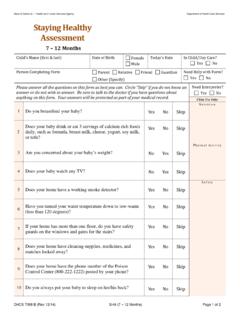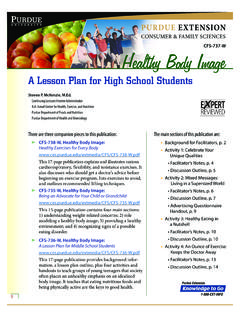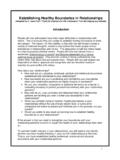Transcription of Healthy Eating for Diabetes - Alberta Health Services
1 Healthy Eating for Diabetes Developed by Registered Dietitians Nutrition Services 607884-NFS What is Diabetes ? Diabetes is when your blood sugar (glucose) levels are higher than normal. For some people, this is because the insulin in their body doesn t work as well as it did before. For other people, their body isn t making any insulin, or isn t making enough insulin. Healthy Eating to manage Diabetes The choices below can help you to manage your Diabetes . Eat 3 meals a day Spreading your food over the day helps control blood sugar. Snacks can reduce hunger between meals. Include snacks if they help you eat smaller portions at your next meal. Spread carbohydrates over the day Your body uses carbohydrate foods for energy. Carbohydrate foods raise your blood sugar.
2 It s important to spread them over the day into smaller meals and snacks. Carbohydrate foods have sugar and starch: grains (wheat, oats, rice, barley, rye) foods made from grains ( bread, tortillas, bannock, naan, roti, pasta, cereal) beans, lentils fruits starchy vegetables (potatoes, yams, corn, squash, parsnips) milk yogurt sweet foods, desserts sugar (table sugar, honey, and molasses) Eat a variety of carbohydrate foods every day to get enough calories (energy), fibre, vitamins, and minerals. A meal that looks like the one below can help you to spread carbohydrate over the day. Fill your plate with vegetables. Put grains and starchy vegetables on of your plate. Some starchy vegetables are potatoes, yams, corn, squash, and parsnips. Put Meat and Alternatives on of your plate.
3 Portion sizes Choosing Healthy portions of food can help you manage your Diabetes and reach and stay at a Healthy weight . Below is a handy guide to help you choose Healthy portion sizes. Use your fist to guide your portions of grain products and fruit. A portion of vegetables can be as much as you could hold in both hands. Use the palm of your hand to guide your portions of meat, fish, or poultry. A portion of Milk and Alternatives is 1 cup (250 mL) of milk or cup (175 mL) of plain or no sugar added yogurt. Vegetables plate Grains and Starchy Vegetables plate Meat and Alternatives plate Milk and Alternatives Fruit Healthy Eating for Diabetes Page 2 of 5 607884-NFS Limit sweet foods and foods with added sugars Sweet foods and foods with added sugar quickly raise blood sugar.
4 Use the tips below to reduce the amount of added sugar you eat and drink. Drink water or sugar-free drinks instead of juice or drinks with added sugar like regular pop, iced tea, and sugar-sweetened coffee and tea drinks. 100% fruit juice doesn t have added sugar, but has a lot of natural sugar. Limit 100% juice to cup (125 mL) a day. Limit sugar, jam, honey, desserts, candy, syrups, and sweet sauces. To sweeten foods like coffee, tea, baking, jams, jellies, and syrups, you can use low-calorie or no-calorie sugar substitutes. Ask your dietitian about using sugar substitutes. Eat more fibre Eating fibre helps you manage your blood sugar levels. Fibre at each meal slows the digestion of food and slows the movement of sugar into your blood. This helps to keep blood sugar from rising too high after a meal.
5 Eating more fibre may also help lower your risk of heart disease. Use the tips below to eat more fibre. Choose higher fibre and whole grain foods more often. High fibre foods have 4 or more grams of fibre in one serving. Choose whole grain breads, cereals, crackers, whole wheat pasta, whole wheat couscous, quinoa, barley, oats, and brown rice. Eat high fibre cereal often, by itself or mixed with another cereal. Eat legumes such as peas, beans, and lentils often. Add them to soups, casseroles, salads, and spaghetti sauce. Choose vegetables or fruit at every meal and snack. Eat these fruits more often: apples, oranges, berries, pears, cherries, plums. Drink more fluid when you increase the amount of fibre you eat.
6 Fibre holds fluid in the stool, which keeps stools soft. Drink at least 9 12 cups ( 3 L) of fluid each day. Water, lower fat milk, and unflavoured soy beverages are the healthiest choices. Limit salt intake Use herbs and spices for flavouring instead of salt. Add little or no salt to cooking or to food at the table. Eat less canned, processed, and packaged foods. Read the Nutrition Facts tables on food labels to find foods lower in sodium. Limit alcohol intake Ask your doctor if drinking alcohol is safe for you. Alcohol may affect your blood sugar control. If you use alcohol, follow Canada s Low Risk Alcohol Drinking Guidelines: Women: 2 or less drinks per day or 10 or less drinks per week Men: 3 or less drinks per day or 15 or less drinks per week One drink of alcohol is: 12 ounces (341 mL) of beer and cider 5 ounces (142 mL) of wine 1 ounces (43 mL) of liquor Alcohol is high in calories.
7 Mixes such as juice or regular pop add sugar and more calories to alcohol. Limit higher sugar drinks like coolers, liqueurs, dessert wines, and mixed drinks. Healthy Eating for Diabetes Page 3 of 5 607884-NFS Choose small amounts of Healthy fat People with Diabetes are more likely to get heart disease. Eating these fats in small amounts can decrease your risk. Some heart Healthy fats are listed below. oils: olive, canola, peanut, sunflower non-hydrogenated margarine nuts and seeds, and nut butters ground flax seeds, chia seeds, or hemp seeds; add these to foods like yogurt, salads or hot cereals Use the tip of your thumb to guide your portions of oils and fats. Cut down on saturated fat Eating saturated fats may increase your risk of heart disease.
8 Use the ideas below. Milk and Alternatives: Choose lower fat milk products (milk, yogurt, cheese). Limit lard and butter. Your thumb is the size of a portion of most cheeses. Meat and Alternatives: Choose lean meats. Limit processed meat like bacon, wieners, deli meat, and sausage. Eat fish at least two times each week. Choose beans, peas, lentils, and tofu more often. Sweets and snack foods: Eat less snack food like chips, salty snacks, baked goods, chocolate bars, and candy. Avoid trans fat Look for foods with little or no trans fat in the Nutrition Facts table on food packages. Cutting back on fat may decrease your calories and help you to manage your weight . Manage your weight The information in this handout can help you manage your weight . If you re at a Healthy weight , try to stay there.
9 If you have extra weight , losing even 5 10% of your weight may help manage your blood sugars. For example, a person that weighs 220 pounds (100 kg) would try to lose 11 22 pounds (5 10 kg). Healthy weight loss is up to 1 2 pounds ( 1 kg) a week. If you would like help with weight loss, ask your doctor to refer you to a dietitian. Next steps This handout includes lifestyle choices that can help you manage your Diabetes . Change can be hard, especially if we try to make too many changes at once. When you re ready to make a change, it can help to set a goal, and break your goals into small steps. You re more likely to achieve smaller goals. Ask your healthcare provider if you would like support with goal setting. Do you have more questions? If you would like more support, ask your healthcare team to refer you to a dietitian.
10 You can also find out more about Diabetes at and Healthy Eating For Diabetes Page 4 of 5 607884-NFS Sample meal ideas The meal ideas on the next pages show how you can use some of the Eating choices in this handout. These are examples only the best meals for you may look different from these. There is space to write your own ideas for meals. Look at the smaller meal plan on this page if you are less active or are trying to eat smaller portions. Look at the larger meal plan on the next page i f you re active or have a larger appetite. Drink water throughout the day. Smaller Meal Plan My Meal Plan Breakfast 1 whole grain English muffin 1 cup (250 mL) skim or 1% milk 1 egg scrambled with: ounce ( 15 g) low fat cheese cup (125 mL) onions, tomato, mushrooms Lunch 1 cup (250 mL) lentil soup 3 4 whole grain crackers (30 grams) cup (175 grams) plain or no sugar added yogurt cup (125 mL) carrots Supper 2 ounces (75 grams) baked salmon cup ( 150 mL) brown rice, cooked 1 cup (250 mL) steamed green beans 1 tsp (5 mL) soft, non-hydrogenated margarine cup (125 mL) sliced tomatoes 1 small pear Snacks If you need help to keep portions smaller at meals, have a small snack between meals.
